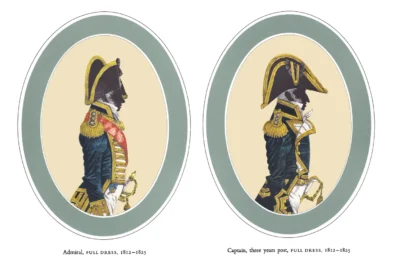John Mollo
These prints were drawn by John Mollo [1931-2017] who was responsible for our prints of The Light Cavalry Brigade in 1864 (The Charge of the Light Brigade) and our heraldic images of some of the leading Knights of the Middle Ages. Mollo had been a military historian and was an adviser to Tony Richardson, the Director, when making the film The Charge of the Light Brigade (1968). He subsequently won 2 Oscars as costume designer for Star Wars Episode IV (directed by George Lucas) in 1977 and another for Gandhi, Directed by Richard Attenborough in 1983. Mollo also won 5 BAFTAs and 3 Primetime Emmys.
The Napoleonic Wars and the RN
The 22 years between 1793, when the French National Convention declared war on Britain, and the final overthrow of Napoleon in 1815 following the Battle of Waterloo, are the most eventful in the long history of the Royal Navy:
The Siege of Toulon, (1793), The Glorious First of June (1794), the Battle of Santa Cruz de Tenerife (1797), the Battle of Camperdown (1797), the Battle of Cape St. Vincent (1797), The Battle of the Nile (1798), the Battle of The Chesapeake (1781), the Battle of Copenhagen (1801) and the Battle of Trafalgar (1805).
Despite early successes at sea, the war started badly. It was not long before Britain’s survival was in the balance. By 1805, however, the fleets of France, Spain, Holland and Denmark had been swept from the seas in a series of victories, and the crisis was over. Thereafter the Navy’s task was to maintain a relentless blockade along almost the whole coast of Europe, and to organise the transportation, protection and supply of the various military expeditions to the continent which, thanks to the Navy, were now possible. These enterprises were not always successful and which finally led to Trafalgar. During this time the Navy suffered some reverses particularly at the hands of the U.S. Navy during the war of 1812. But the tradition and the training instilled into the Royal Navy by Nelson and his contemporaries had a profound effect on the course of the war, and it was only right that, when the end came, Napoleon decided to surrender himself to the captain of a British ship of the line.
This period has always caught the imagination. Relics of the Napoleonic Wars, and prints and paintings of the ships and men that took part in them are extremely rare. Illustrations of naval uniform are few and far between, but sets of engravings like that by Dominic Serres, published in 1777, or that by Rowlandson which appeared in 1799, are unobtainable. The uniforms here are some of those worn during the war years when, in 1787, the uniforms in use at the outbreak of hostilities were authorised. Until 1748 no one wore uniform. Until 1857 only officers did, seamen wore clothing sold by the Purser or made of materials issued from his stores; custom, and the fact that the ingredients were purchased in bulk, led to a degree of uniformity. The traditional ‘Jack Tar’ with his tarpaulin hat, black or coloured neckerchief, blue jacket with shiny buttons, white trousers and buckled shoes, began to make his appearance at about the end of the eighteenth century.
The first uniform for naval officers was introduced, at their own request, in 1748. Before that red was the most popular colour. But now blue with white facings and gold lace took its place, and became the livery of the Royal Navy until the present day. There is an apocryphal story that these colours were chosen by George II after seeing the Duchess of Bedford wearing a riding habit of the same. The 1748 uniforms lasted, with small alterations until 1767, when full dress was abolished. In 1774 it was restored to captains and commanders, and in 1783 for flag officers. In 1787 new uniforms were authorised which were still in use when the war started in 1793.










